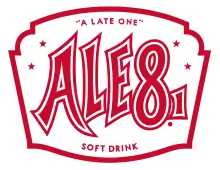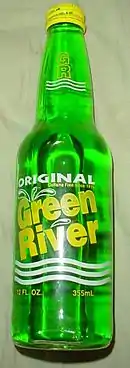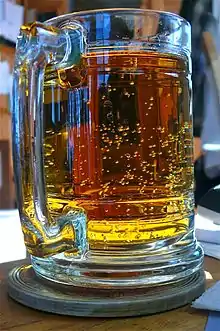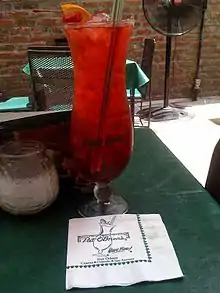List of regional beverages of the United States
The following is a list of notable beverages associated with (and often limited to) specific regions[1][2][3][4] of the United States. See also: List of regional dishes of the United States.
Non-alcoholic drinks
| Image | Drink Name | Associated Region | Description |
|---|---|---|---|
 Ale-8-One |
Ale-8-One | Kentucky | A ginger and citrus blend, containing less carbonation and fewer calories than conventional soda, Ale-8-One was first sold in 1920s Prohibition-era Kentucky—according to the company, thirsty locals used it as a mixer to improve the taste of bootleg liquor.[5] Often abbreviated as Ale-8, the name Ale-8-One is itself a pun on the original title; it was originally called "A Late One" after a contest was held at a county fair to name the beverage. |
 Apple Beer |
Apple Beer | Utah | Non-alcoholic and uncaffeinated, this Salt Lake City brew is an American variant of the Bavarian Fassbrause. It is commonly used as a non-alcoholic alternative for celebratory toasts (in Utah, religious abstinence[6] from both alcohol and caffeine is not uncommon). |
 Birch Beer |
Birch Beer | Northeastern United States | A carbonated soft drink made from herbal extracts and birch bark or sap. |
| Boost! | New Jersey (especially Burlington County) | Not to be confused with a similarly named meal replacement drink, Boost! is a non-carbonated fruit syrup first sold in 1913 under the name Tak-Aboost. Boost! has been described as having a taste like "flat Coke." While it can be hard to find on store shelves outside of South Jersey, the company ships thousands of gallons worldwide each year.[7] | |
| Boston Cooler | Detroit | Boston Coolers might be mistaken for a Massachusetts invention, but they were invented in the Boston-Edison neighborhood of Detroit. They are made with softened vanilla ice cream and ginger ale—purists insist on the local Michigan brand Vernors. Unlike a traditional ice cream float, Boston Coolers are blended thick like a milkshake. | |
 Cel-Ray |
Cel-Ray | New York City and Florida | First produced in 19th-century Brooklyn, Cel-Ray is a kosher, carbonated celery-flavored soft drink. Derived from celery seed extract, it is commonly found in Jewish delicatessens in New York City and South Florida. |
 Cheerwine |
Cheerwine[8] | North Carolina | A cherry-flavored soft drink that has been made by the Carolina Beverage Corporation since 1917. |
 Chicory Coffee |
Chicory Coffee | New Orleans | In the 1840s, the port of New Orleans was America's second-largest importer of coffee (after New York). When Union naval blockades interrupted the flow of coffee into Confederate New Orleans during the American Civil War, Louisianans began to add chicory root to their coffee as a substitute[9]—thus starting a tradition that continues to this day. |
Coca-Cola |
Coca-Cola and Peanuts[10] | Southern United States | This Southern recipe is a simple one: open a glass of Coca-Cola and just drop a few shelled, salted peanuts into the bottle. The sweetness of the soda pairs with the salt from the peanuts. |
 Coffee milk |
Coffee milk | The official state drink of Rhode Island[11] | A drink made by mixing coffee syrup or coffee extract and milk together[12] |
 Date Milkshake |
Date shake | Palm Springs, California & Coachella Valley | A milkshake made with dates; the local climate is ideal for growing date palm trees. |
 Dr. Enuf |
Dr. Enuf | Tennessee | Dr. Enuf is a vitamin-enriched lemon-lime soft drink that is widely available in the Tri-Cities of Northeast Tennessee. |
 Dr. Nut |
Dr. Nut | New Orleans | No longer in production, Dr. Nut was a New Orleans soft drink with a distinct almond flavor, similar to Amaretto. It was immortalized in John Kennedy O'Toole's novel A Confederacy of Dunces as Ignatius J. Reilly's favorite beverage. |
 Egg Cream |
Egg cream | New York City | Made with neither eggs nor cream, this fountain beverage was invented in Brooklyn and is usually made with chocolate syrup, seltzer and milk. |
 Faygo |
Faygo[13] | Michigan, Midwestern United States, Mid-Atlantic (United States) and South Central United States | A soft drink manufactured in Detroit that has been mentioned in several rap songs, most notably by Insane Clown Posse. |
| Grapico | Alabama | Grapico is a caffeine-free, artificially flavored carbonated soft drink with a purple color and a grape taste sold in the Southeastern United States since 1916—but it's particularly associated with its home state of Alabama. Grapico is mentioned in Fried Green Tomatoes at the Whistle Stop Cafe, 1987 best selling novel by Fannie Flagg.[14] | |
.jpg.webp) |
Green Chile Lemonade | New Mexico | Green chile is an integral component of New Mexico's cuisine—so much so that you can even find lemonade with green chile in it. |
 |
Green River | Illinois | Green River is frequently marketed as a nostalgia item, and its sales increase in March due to the association of the color green with St. Patrick's Day[15] (when the Chicago River turns into a literal green river.) While not widely commercially available, it can be purchased at some Chicago area restaurants and retailers.[16] According to Creedence Clearwater Revival frontman John Fogerty, this drink was the inspiration for the song Green River.[17] |
 Ironport |
Ironport | Intermountain West states including Utah, Idaho, Montana, Wyoming, and Nevada. | Described as somewhat of a cross between root beer and Caribbean spices, or root beer and cream soda, ironport (or iron port) is a style of beverage created in the early 20th century and still available at soda fountains in the Western United States. |
.jpg.webp) Kona Coffee |
Kona Coffee | Hawaii | Kona coffee is the market name for coffee (Coffea arabica) cultivated on the slopes of Hualalai and Mauna Loa in the North and South Kona Districts of the Big Island of Hawaii. It is one of the most expensive coffees in the world. According to Hawaiian law, only coffee from the Kona Districts can be described as "Kona." Because of the rarity and price of Kona coffee, some retailers sell "Kona Blends"—which are often the minimum required 10% Kona coffee and 90% cheaper imported beans. Some retailers use terms such as "Kona Roast" or "Kona Style," but to be considered authentic Kona coffee, the state of Hawaii's labeling laws require the prominent display of the words "100% Kona Coffee". |
.jpg.webp) Manhattan Special |
Manhattan Special | New York City | Manhattan Special, made with espresso beans, seltzer water and sugar, has adorned New York City store shelves for over a century. Created in 1895 by Italian immigrant Michael Garavuso, the company's petite glass bottles were once carried to market from their Manhattan Avenue, Brooklyn bottling plant by horse and buggy.[18] |
 Byrne Dairy |
Mint Milk | New York State (around Syracuse) | You can find mint milk in central New York grocery stores every spring. The green, mint-flavored milk,[19] produced by Byrne Dairy, is a Saint Patrick's Day-themed treat. |
 Moxie |
Moxie[20] | Maine, New England and Houston | One of the first mass-produced soft drinks in the United States, this carbonated Gentian-root extract beverage is the official soft drink of Maine.[21] |
 |
Piñon coffee | New Mexico | Pine nut coffee, known as piñón (Spanish for pine nut), is a specialty found in the southwest United States, especially New Mexico, and is typically a dark roast coffee having a deep, nutty flavor; roasted and lightly salted pine nuts can often be found sold on the side of the road in cities across New Mexico to be used for this purpose, as well as a snack. |
 |
POG (Passion Orange Guava) | Hawaii | POG juice is a tropical beverage from the Hawaiian islands made with equal parts passion fruit, orange, and guava juices (hence the name POG). POG was created in 1971 by a food product consultant named Mary Soon, who worked for Haleakala Dairy in Maui. Haleakala Dairy's flat cardboard bottle caps became the inspiration for the popular 1990s game POG. |
 Ski soda bottles |
Ski | Although the origins to Ski have no known connection to the city of Evansville, Indiana, the product is very popular there, and has become a significant part of the local culture.[22][23] | A citrus soda made using orange and lemon juice |
 Sweet tea |
Sweet tea[24] | Southern United States | A sugary Southern variant of iced tea. |
.jpg.webp) Switchel |
Switchel | New England | Switchel—made with apple cider vinegar, ginger, water, and a sweetener like molasses or maple syrup—has been enjoyed by New Englanders for hundreds of years. Colonial-era farm workers, seeking refreshment on hot harvest days, drank switchel out of stone jugs that they kept in the shade. Switchel can be either non-alcoholic or mixed with spirits. In recent years there has been renewed interest in the beverage.[25] |
 Vernors ginger ale |
Vernors | For most of its history, Vernors was a regional product available throughout Michigan and in major regional cities such as Toledo, Cleveland, and Buffalo. It is also popular in Canada, having been sold at Ontario soda fountains from the 1920s onward, and with bottling facilities, soda fountains and outlets located in Southwestern Ontario.[26] It was not mass distributed nationally in the U.S. until the 2000s. | Ginger soda |
Alcoholic drinks
| Image | Drink Name | Associated regions | Description |
|---|---|---|---|
| Allen's Coffee Brandy[27] | Maine and New England | Allen's Coffee Brandy is a coffee-flavoured liqueur popular in New England, especially Maine, where it was the best-selling liquor product from the mid-2000s to 2018 (when it was unseated by Fireball Cinnamon Whisky). | |
| Boilo | Pennsylvania | Boilo, a variation of a traditional Lithuanian liqueur called "Krupnik" or "Krupnikas," is a spiced citrus drink traditionally enjoyed at Christmastime in Pennsylvania coal country. | |
| Crémas[28] | Miami | A creamy Haitian drink that can be found in Little Haiti, a section of Miami. Similar to an eggnog, this drink is made with milk, coconut, rum and other ingredients. Also spelled Kremas or Crémasse. | |
| Horsefeather | Invented in Lawrence, Kansas in the 1990s,[29] it remains a regional drink in the Kansas City region.[30] | A cocktail traditionally prepared using rye whiskey[31] or blended whiskey, ginger beer, three dashes of Angostura bitters, and a little lemon juice.[32] | |
 Hurricane |
Hurricane | New Orleans | The hurricane cocktail is a sweet alcoholic drink made with rum, lemon juice, and passion fruit syrup. It is one of many popular drinks served in New Orleans. It is traditionally served in the tall, curvy eponymous "hurricane glass." Disposable plastic cups are also used for while New Orleans laws permit drinking in public and leaving a bar with a drink, it prohibits public drinking from glass containers. |
| Jeppson's Malört | Chicago | Malört, a brand of bäsk, is a wormwood-based Swedish liquor found in Chicago. Due to its exceptionally bitter taste, many imbibers experience "Malört face" on first sampling the drink.[33] | |
 Mojito |
Mojito | Miami | Mojitos are a rum-based highball cocktail, of Cuban origins, most commonly associated with South Florida. |
 Moonshine |
Moonshine | Appalachia, Southern United States | A clear and unaged corn mash whiskey most commonly associated with Appalachian & Southeastern states. "White lightning" was both illegal and in great demand during Prohibition. |
| National Bohemian[34] | Baltimore | Nearly 90% of 'Natty Boh' sales are in Baltimore, Maryland where this pilsener beer was originally brewed. | |
| Nutcracker | New York City | Nutcrackers[35] are illegal, generally homemade liquor & juice drinks sold by New York City street vendors. You might hear bootleggers hawking their wares (shouting "Nutcracker!") at city beaches. | |
 Ramos Gin Fizz |
Ramos gin fizz[36] | New Orleans | A frothy cocktail made famous by Louisiana Governor Huey Long. Legend has it that Huey brought his New Orleans bartender with him on a business trip to New York because he couldn’t do without his Ramos as perfected by his favorite bartender. He called it “his gift to New York.” |
 Sazerac |
Sazerac[37][38] | New Orleans | A cocktail made with rye, absinthe or Herbsaint, Peychaud's Bitters, and sugar. The state of Louisiana named Sazerac the official cocktail of New Orleans in 2008.[39] |
 Rum and Diet Coca-Cola |
Moonshine | Atlanta, Georgia | A dark fizzy soda and a splash of rum, popular among Floridian cruisers. You might hear a bargoer order "D.C. with rum," which refers to this drink. |
See also
- List of national drinks – a national drink is a distinct beverage that is strongly associated with a particular country, and can be part of their national identity and self-image
- List of beverages of the Southern United States
- List of regional dishes of the United States
- Prohibition in the United States
References
- "A Tour of America's Beloved Regional Cocktails". Punch. July 3, 2019. Retrieved June 28, 2019.
- Weisstuch, Liza (April 4, 2019). "8 Excellent Regional Cocktails Across America". Budget Travel. Retrieved June 28, 2019.
- Sant, Laura (May 14, 2019). "The 11 Best Hyper-Regional Sodas in America". Saveur. Retrieved June 28, 2019.
- Hansen, Zak (May 3, 2017). "13 Regional Sodas That Should Be Sold in Every State". Wide Open Eats. Retrieved June 28, 2019.
- "Cocktails". Ale-8-One. Retrieved 2019-08-22.
- "Can Mormons Drink Coca-Cola?". NPR.org. Retrieved 2019-08-15.
- Rowan, Tommy (September 15, 2017). "A flat, thick, weird-tasting soda you'll only find in Jersey: 'This is our crack'". The Philadelphia Inquirer. Retrieved 2019-08-15.
- Allen, Scott (2015-07-15). "Drink Up! The Stories Behind 11 Regional Soft Drinks". mentalfloss.com. Retrieved 2019-06-27.
- Guas, David. (2009). DamGoodSweet : desserts to satisfy your sweet tooth, New Orleans style. Pelzel, Raquel. Newtown, CT: Taunton Press. ISBN 9781600851186. OCLC 313654084.
- "Coke and Peanuts: A Food Historian Speculates on How it Got Started". The Coca-Cola Company. Retrieved 2019-08-15.
- RI.gov. "State of Rhode Island website "Facts and Figures"". Ri.gov. Retrieved 2011-11-28.
- Shahidi, F.; Spanier, A.M.; Ho, C.T.; Braggins, T. (2003). Quality of Fresh and Processed Foods. Advances in Experimental Medicine and Biology. Springer US. p. 207. ISBN 978-0-306-48071-3. Retrieved August 17, 2017.
- Joe Grimm (2018). The Faygo Book. Wayne State University Press. ISBN 978-0-8143-4585-6.
- Flagg, Fannie. Fried green tomatoes at the Whistle Stop Cafe (First McGraw-Hill paperback ed.). New York. ISBN 0070212570. OCLC 17805662.
- Heil, Meredith (2016-08-25). "16 Hard-to-Find Sodas We Wish Were Everywhere". Thrillist. Retrieved 2019-08-22.
- Miastkowski, Raf (2016-05-13). "Things You Didn't Know About Green River Soda". Thrillist. Retrieved 2019-08-22.
- "Fogerty 1993 Rolling Stone Interview. Part 2 of 3". riverising.tripod.com. Retrieved 2019-08-22.
- Wilson, Michael (2008-07-03). [nytimes.com/2008/07/07/nyregion/07coffee.html "A Modern Comeback for a Taste of Brooklyn"] Check
|url=value (help). nytimes.com. Retrieved 2019-08-29. - Tulloch, Katrina (2019-03-12). "Mint milk from Byrne Dairy: A sure sign of spring, Irish pride in Syracuse (video)". syracuse.com. Retrieved 2019-08-15.
- Waugh, Danielle (August 29, 2018). "Maine Split on Coca-Cola's Acquisition of Moxie". NBC10 Boston. Retrieved 2019-06-25.
- Office of the Revisor of Statutes (2005). "Title 1, Section 224 of General Provisions: Seal, Motto, Emblems and Flags". State House of Maine. Retrieved 7 December 2014.
- Reynolds, Ryan (August 8, 2016). "Ski, unofficial soft drink of the West Side, turning 60". Courier & Press. Retrieved July 6, 2019.
- Cornish, Eric. "You Know You're From Evansville When…". 99.5 WKDQ.
- Powers, Sean (June 9, 2016). "Sweet Tea: A History Of The 'Nectar Of The South'". www.gpbnews.org. Retrieved 2019-06-25.
- "Switchel: The Best Summer Drink You've Never Heard Of". Food & Wine. Retrieved 2019-08-15.
- Wunderlich, Keith (2008). Wunderlich, Keith, '"Vernors Ginger Ale, Arcadia Publishing, 2008 ISBN 0-7385-5185-6, ISBN 978-0-7385-5185-2. ISBN 9780738551852. Retrieved 2010-02-13.
- Fahrenthold, David A. (2006-01-09). "A Bittersweet 'Champagne of Maine'". Retrieved 2019-06-25.
- "Recipe for Haitian Cremasse". Martha Stewart. 2012-09-21. Retrieved 2019-06-25.
- Simonson, Robert (November 27, 2017). "Cocktails Only a Local Could Love". The New York Times. Retrieved March 27, 2018.
- Frechette, Chloe (March 31, 2017). "Three-Drink Minimum: Bartending with Ryan Maybee". PUNCH. Retrieved March 27, 2018.
- Shepherd, Sara (November 25, 2012). "Lawrence Libations: Horsefeather at The Bourgeois Pig". Lawrence.com. Retrieved June 1, 2018.
- "Q/A with Ryan Maybee of Paris of the Plains Cocktail Festival". Imbibe. August 11, 2014. Retrieved March 27, 2018.
- Chu, Louisa (February 22, 2019). "After 30 Years, Malort Is Home. Production of the Bitter Liqueur Returned to Chicago in October 2018 after being acquired by CH Distillery". Chicago Tribune. Retrieved August 14, 2019.
- Maza, Erik (January 26, 2011). "National Bohemian beer to be served on draft again". baltimoresun.com. Retrieved 2019-06-25.
- Lee, Trymaine (2010-09-20). "In Harlem, Nutcracker Drink Is Popular but Risky". The New York Times. ISSN 0362-4331. Retrieved 2019-08-15.
- "Ramos Gin Fizz". www.neworleans.com. Retrieved 2019-06-25.
- Boggs, Lindy (June 26, 2008). "New Orleans Declares Sazerac Its Cocktail of Choice". NPR. Retrieved June 30, 2019.
- Santopietro, Jill (July 15, 2009). "Tales of a Cocktail: Sampling Sazeracs in New Orleans". New York Times. Retrieved June 30, 2019.
- "Louisiana State Legislature". legis.la.gov. Retrieved 2019-08-22.
This article is issued from Wikipedia. The text is licensed under Creative Commons - Attribution - Sharealike. Additional terms may apply for the media files.